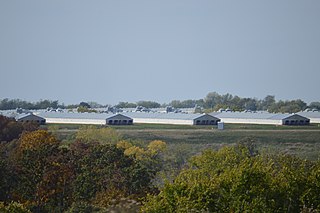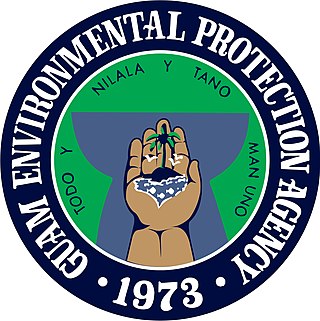Related Research Articles

Environmental laws are laws that protect the environment. Environmental law is the collection of laws, regulations, agreements and common law that governs how humans interact with their environment. This includes environmental regulations; laws governing management of natural resources, such as forests, minerals, or fisheries; and related topics such as environmental impact assessments.Environmental law is seen as the body of laws concerned with the protection of living things from the harm that human activity may immediately or eventually cause to them or their species, either directly or to the media and the habits on which they depend.

The Environmental Protection Agency (EPA) is an independent executive agency of the United States federal government tasked with environmental protection matters. President Richard Nixon proposed the establishment of EPA on July 9, 1970; it began operation on December 2, 1970, after Nixon signed an executive order. The order establishing the EPA was ratified by committee hearings in the House and Senate.

Orica Limited is an Australian-based multinational corporation that is one of the world's largest providers of commercial explosives and blasting systems to the mining, quarrying, oil and gas, and construction markets, a supplier of sodium cyanide for gold extraction, and a specialist provider of ground support services in mining and tunnelling.

In animal husbandry, a concentrated animal feeding operation, as defined by the United States Department of Agriculture (USDA), is an intensive animal feeding operation (AFO) in which over 1,000 animal units are confined for over 45 days a year. An animal unit is the equivalent of 1,000 pounds of "live" animal weight. A thousand animal units equates to 700 dairy cows, 1,000 meat cows, 2,500 pigs weighing more than 55 pounds (25 kg), 10,000 pigs weighing under 55 pounds, 10,000 sheep, 55,000 turkeys, 125,000 chickens, or 82,000 egg laying hens or pullets.

In environmental law, the polluter pays principle is enacted to make the party responsible for producing pollution responsible for paying for the damage done to the natural environment. This principle has also been used to put the costs of pollution prevention on the polluter. It is regarded as a regional custom because of the strong support it has received in most Organisation for Economic Co-operation and Development (OECD) and European Union countries. It is a fundamental principle in US environmental law.

The New South Wales Office of Environment and Heritage (OEH), a former division of the Government of New South Wales between April 2011 and July 2019, was responsible for the care and protection of the environment and heritage, which includes the natural environment, Aboriginal country, culture and heritage, and built heritage in New South Wales, Australia. The OEH supported the community, business and government in protecting, strengthening and making the most of a healthy environment and economy within the state. The OEH was part of the Department of Planning and Environment cluster and managed national parks and reserves.

Vales Point Power Station is one of two operating coal fired power stations on the shores of Lake Macquarie, New South Wales. Vales Point is located on the southern shore of the lake, near the township of Mannering Park. It has two steam turbines, with a total generating capacity of 1,320 MW of electricity.

Reorganization Plan No. 3 was a United States presidential directive establishing the Environmental Protection Agency (EPA), effective December 2, 1970. The order, published in the Federal Register on October 6, 1970, consolidated components from different federal agencies to form the EPA, "a strong, independent agency" that would establish and enforce federal environmental protection laws.

The California Environmental Protection Agency, or CalEPA, is a state cabinet-level agency within the government of California. The mission of CalEPA is to restore, protect and enhance the environment, to ensure public health, environmental quality and economic vitality.
The Environmental Protection Authority of Western Australia (EPA) is a statutory authority within the Government of Western Australia, established on 1 January 1972, which acts as the primary provider of independent environmental advice to the government. Since 27 November 2009 it has been supported administratively by the Office of the Environmental Protection Authority (OEPA), which was amalgamated with the Department of Environment Regulation and the Department of Water to form the Department of Water and Environmental Regulation on 1 July 2017. It operates under the Environmental Protection Act 1986.

Kooragang is the northernmost and largest suburb of the city of Newcastle, in the Hunter Region of New South Wales, Australia. Dominated by Kooragang Island, the eastern part of the suburb is primarily industrial, while the western part of the suburb consists of nature reserves. Covering an area of 35.4 km2 (13.7 sq mi), at the 2016 census, there were no people living in the suburb.
To protect the environment from the adverse effects of pollution, many nations worldwide have enacted legislation to regulate various types of pollution as well as to mitigate the adverse effects of pollution. At the local level, regulation usually is supervised by environmental agencies or the broader public health system. Different jurisdictions often have different levels regulation and policy choices about pollution. Historically, polluters will lobby governments in less economically developed areas or countries to maintain lax regulation in order to protect industrialisation at the cost of human and environmental health.
Robyn Mary Parker, is a former Australian politician, and was a member of the New South Wales Legislative Assembly representing Maitland for the Liberal Party from 2011 to 2015 and was previously a member of the Legislative Council of New South Wales between 2003 and 2011. Parker was the New South Wales Minister for the Environment and the Minister for Heritage in the O'Farrell government from 2011 until April 2014. Parker was succeeded by Rob Stokes in the Baird cabinet.

The Office of Enforcement and Compliance Assurance (OECA) is the law enforcement arm of the United States Environmental Protection Agency (EPA). It is made up of attorneys, special agents, scientists and other employees.

An ash pond, also called a coal ash basin or surface impoundment, is an engineered structure used at coal-fired power stations for the disposal of two types of coal combustion products: bottom ash and fly ash. The pond is used as a landfill to prevent the release of ash into the atmosphere. Although the use of ash ponds in combination with air pollution controls decreases the amount of airborne pollutants, the structures pose serious health risks for the surrounding environment.

Waste management laws govern the transport, treatment, storage, and disposal of all manner of waste, including municipal solid waste, hazardous waste, and nuclear waste, among many other types. Waste laws are generally designed to minimize or eliminate the uncontrolled dispersal of waste materials into the environment in a manner that may cause ecological or biological harm, and include laws designed to reduce the generation of waste and promote or mandate waste recycling. Regulatory efforts include identifying and categorizing waste types and mandating transport, treatment, storage, and disposal practices.

The Environment Protection Authority Victoria (EPA) is Victoria’s environmental regulator. EPA is an independent statutory authority, established in 1971 under the Environment Protection Act 1970. EPA's role is to prevent and reduce the harmful effects of pollution and waste on Victorians and their environment.

The Guam Environmental Protection Agency is a government agency of the United States territory of Guam.
Water in Arkansas is an important issue encompassing the conservation, protection, management, distribution and use of the water resource in the state. Arkansas contains a mixture of groundwater and surface water, with a variety of state and federal agencies responsible for the regulation of the water resource. In accordance with agency rules, state, and federal law, the state's water treatment facilities utilize engineering, chemistry, science and technology to treat raw water from the environment to potable water standards and distribute it through water mains to homes, farms, business and industrial customers. Following use, wastewater is collected in collection and conveyance systems, decentralized sewer systems or septic tanks and treated in accordance with regulations at publicly owned treatment works (POTWs) before being discharged to the environment.

Waste management in Australia started to be implemented as a modern system by the second half of the 19th century, with its progresses driven by technological and sanitary advances. It is currently regulated at both federal and state level. The Commonwealth's Department of the Environment and Energy is responsible for the national legislative framework.
References
- ↑ Needham, Kristy. "NSW Budget 2016: Winners and losers". Bunbury Mail. Bunbury Mail. Retrieved 11 July 2016.
- ↑ Clennel, Andrew (21 January 2016). "Minister creates climate of change". The Daily Telegraph . Retrieved 5 July 2016.
- ↑ "Protection of The Environment Operations Act 1997". Australasian Legal Information Institute. Retrieved 5 July 2016.
- ↑ O'Brien, Natalie (18 September 2011). "Big polluter goes unchecked". Sydney Morning Herald . Retrieved 5 July 2016.
- ↑ O'Reilly, Brendan. "A review into the response to the serious pollution incident at Orica Australia Pty. Ltd. ammonium nitrate plant at Walsh Point, Kooragang Island on August 8, 2011" (PDF). Retrieved 5 July 2016.
- ↑ Cox, Dan; Cook, Carly (28 April 2016). "Study finds chemical giant contributing to Newcastle air pollution". ABC News . Retrieved 5 July 2016.
- ↑ Cormack, Lucy (14 February 2016). "NSW waste still travelling across state borders prompting EPA investigations". Sydney Morning Herald. Retrieved 5 July 2016.
- ↑ Tan, Monica (5 June 2015). "Coal miner's toxic wastes killing aquatic life in protected Blue Mountains river". The Guardian . Retrieved 5 July 2016.
- ↑ "EPA fines Inverell Freighters $14,000 for dangerous goods offences". Logistics & Materials Handling. 6 June 2016. Retrieved 5 July 2016.
- ↑ Carter, Lucy (22 February 2016). "NSW EPA to investigate 'historical legacy' or perflourinated compounds". ABC News. The World Today with Eleanor Hall. Retrieved 5 July 2016.
- ↑ "Man fined for pesticide misuse". The Land. 25 August 2015. Retrieved 5 July 2016.
- ↑ "Radiation Control Regulation 2013". Australasian Legal Information Institute. New South Wales Government. Retrieved 5 July 2016.
- ↑ O'Brien, Natalie (13 December 2015). "Six investigations underway into operations of state-owned corporation". Sydney Morning Herald . Retrieved 5 July 2016.
- ↑ Smith, Kerry (16 June 2016). "Contamination concerns after CSG wells flood". Green Left Weekly . Retrieved 5 July 2016.